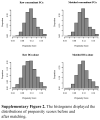Clinicopathologic characteristics and outcomes of prostate cancer incidentally discovered at the time of radical cystoprostatectomy: a population-based cohort study
- PMID: 38537072
- PMCID: PMC11254266
- DOI: 10.1097/JS9.0000000000001401
Clinicopathologic characteristics and outcomes of prostate cancer incidentally discovered at the time of radical cystoprostatectomy: a population-based cohort study
Abstract
Objective: This study aimed to comprehensively analyze the clinical characteristics and prognosis of patients with concomitant bladder cancer (BCa) and prostate cancer (PCa) using a large population-based database.
Methods: Within the Surveillance, Epidemiology, and End Results (SEER) database (2000-2019), the authors identified patient with concomitant PCa at the time of radical cystoprostatectomy (RCP). Logistic regression and propensity score matching (PSM) analyses were employed to identify risk factors and mitigate confounders, respectively. Kaplan-Meier survival curves were used to estimate cancer-specific survival (CSS).
Results: A total of 14 199 BCa patients undergoing RCP were identified, with 28.8% incidentally discovered to have concurrent PCa. Among them, 89.9% exhibited organ-confined (T1-2) PCa. An increased risk of concomitant tumors was observed among older age, white race, and high tumor grade of BCa. Survival analysis revealed no significant difference in CSS between patients with BCa alone and those with concurrent PCa (5-year CSS rate: 71.3 vs. 67.2%, P =0.076). Subgroup analysis and multivariable analysis, however, indicated that concurrent high-risk PCa adversely impacted survival (5-year CSS rate: 71.3 vs. 63.4%, HR 1.27, 95% CI: 1.01-1.58, P =0.038) compared to solitary BCa. Notably, the presence of low/intermediate-risk PCa did not affect survival outcomes ( P =0.584).
Conclusion: In conclusion, incidentally discovered PCa in RCP specimens is frequent and characterized by organ-confined presentation, lower PSA levels, and Gleason scores. Patients with concurrent high-risk PCa have a worse prognosis compared to those with solitary BCa, while the presence of low/intermediate-risk PCa does not influence oncological prognosis.
Copyright © 2024 The Author(s). Published by Wolters Kluwer Health, Inc.
Conflict of interest statement
The authors have no potential conflicts of interest to disclose.
Sponsorships or competing interests that may be relevant to content are disclosed at the end of this article.
Figures




Similar articles
-
Concomitant Gleason Score ≥ 7 prostate cancer is an independent prognosticator for poor survival in nonmetastatic bladder cancer patients undergoing radical cystoprostatectomy.Int Urol Nephrol. 2015 Nov;47(11):1789-96. doi: 10.1007/s11255-015-1110-1. Epub 2015 Sep 16. Int Urol Nephrol. 2015. PMID: 26377495
-
Assessment of 5-year overall survival in bladder cancer patients with incidental prostate cancer identified at radical cystoprostatectomy.Int Urol Nephrol. 2019 Sep;51(9):1527-1535. doi: 10.1007/s11255-019-02181-7. Epub 2019 Jun 10. Int Urol Nephrol. 2019. PMID: 31183659
-
Clinicopathological characteristics of incidental prostate cancer discovered from radical cystoprostatectomy specimen: a multicenter French study.Ann Surg Oncol. 2014 Feb;21(2):684-90. doi: 10.1245/s10434-013-3340-8. Epub 2013 Oct 30. Ann Surg Oncol. 2014. PMID: 24170436
-
Clinicopathologic features of prostate adenocarcinoma incidentally discovered at the time of radical cystectomy: an evidence-based analysis.Eur Urol. 2007 Sep;52(3):648-57. doi: 10.1016/j.eururo.2007.06.016. Epub 2007 Jun 21. Eur Urol. 2007. PMID: 17600614 Review.
-
Do we use the right criteria for determining the clinical significance of incidental prostate cancer at radical cystoprostatectomy?Scand J Urol. 2013 Oct;47(5):358-62. doi: 10.3109/00365599.2012.723045. Epub 2012 Oct 18. Scand J Urol. 2013. PMID: 23078550 Review.
Cited by
-
Tumor hypoxia in immune infiltration and prognosis of bladder cancer.Transl Cancer Res. 2024 Jul 31;13(7):3273-3284. doi: 10.21037/tcr-23-2375. Epub 2024 Jul 26. Transl Cancer Res. 2024. PMID: 39145090 Free PMC article.
-
A histopathological snapshot of bladder cancer: a Johannesburg experience of 1480 histopathology reports.World J Urol. 2025 Mar 11;43(1):159. doi: 10.1007/s00345-025-05540-5. World J Urol. 2025. PMID: 40064690 Free PMC article.
References
-
- Luchey AM, Lin HY, Yue B, et al. . Implications of definitive prostate cancer therapy on soft tissue margins and survival in patients undergoing radical cystectomy for bladder urothelial cancer. J Urol 2015;194:1220–1225. - PubMed
-
- Barbisan F, Mazzucchelli R, Scarpelli M, et al. . Urothelial and incidental prostate carcinoma in prostates from cystoprostatectomies for bladder cancer: is there a relationship between urothelial and prostate cancer? BJU Int 2009;103:1058–1063. - PubMed
-
- Lopez-Beltran A, Cheng L, Montorsi F, et al. . Concomitant bladder cancer and prostate cancer: challenges and controversies. Nat Rev Urol 2017;14:620–629. - PubMed
MeSH terms
LinkOut - more resources
Full Text Sources
Medical
Research Materials
Miscellaneous

